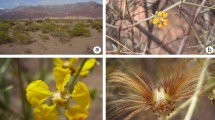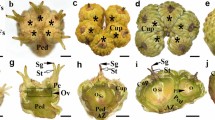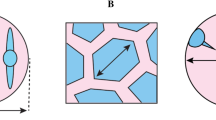Abstract
Self-pollination conditions have been recorded frequently in local populations of the genus Epipactis, and structural modifications have sometimes been reported, supporting taxonomic recognition of new species. As part of a survey of gynostemium micromorphology of Italian Epipactis populations, we studied an Apennine population of Epipactis microphylla (Ehrh.) Sw. a species listed as autogamous but with residual allogamous characters. In this population we observed the tendency to perform pre-anthesis cleistogamy. However, self-pollination was not a consequence of modification in column morphology. Cryptic pollen germination occurred in anther thecae or in the clinandrium, bypassing any contact with the receptive stigma. Pollen germination started from the distal pool of the pollinium, close to the rostellum-viscidium, suggesting that the rostellum-viscidium may have a function in promoting pollen-tube growth. Germinated pollen was exposed at the anthesis.




Similar content being viewed by others
References
Anderson WR (1980) Cryptic self-fertilization in the Malpighiaceae. Science 207:892–893
Bateman RM (2001) Evolution and classification of European orchids: insights from molecular and morphological characters. J Eur Orch 33:33–119
Burns-Balogh P, Szlachetko DL, Dafni A (1987) Evolution, pollination and systematic of the tribe Neottieae (Orchidaceae). Plant Syst Evol 156:91–115
Catling PM (1990) Auto-pollination in Orchidaceae. In: Arditti J (ed) Orchid biology, reviews and perspectives, vol V. Timber Press, Portland, pp 121–158
Claessens J, Kleynen J (1996) Allogamie- und Autogamie- Tendenzen bei einigen Vertreten der Gattung Epipactis. Ber Arbeitskr Heim Orch 12:4–16
Delforge P (1995) Orchids of Britain and Europe. Harper-Collins, London
Delforge P (2001) Guide des Orchidées d’Europe. Delachaux and Niestlé, Lausanne
Dressler RL (1993) Phylogeny and classification of the orchid family. Cambridge University Press, Cambridge
Ehlers BK, Pedersen HAE (2000) Genetic variation in three species of Epipactis (Orchidaceae): geographic scale and evolutionary inferences. Biol J Linn Soc 69:411–430
Franchi GG, Nepi M, Dafni A, Pacini E (2002) Partially hydrated pollen: taxonomic distribution, ecological and evolutionary significance. Plant Syst Evol 234:211–227
Grilli Caiola M, Brandizzi F, Canini A (2000) Hermodactylon tuberosus L. (Iridaceae) pollen organization before and after anther dehiscence. Plant Biosyst 134:353–364
Grünanger P (2000) Orchidaceae d’Italia. Quad Bot Ambientale Appl 11:65–71
Johnson SA, McCormick S (2001) Pollen germinates precociously in the anthers of raring-to-go, an Arabidopsis gametophytic mutant. Plant Physiol 126:685–695
Kurzweil H (1988) Developmental studies in orchid flowers III: Neottioid species. Nord J Bot 8:271–282
Lord EM (1981) Cleistogamy is a tool for the study of floral morphogenesis, function and evolution. Bot Rev 47:421–449
Mayers AM, Lord EM (1984) Comparative flower development in the cleistogamous species Viola odorata: III. A histological study. Bot Gaz 145:83–91
Mered’a P (1996a) Epipactis pseudopurpurata Mered’a, spec. nova (Orchidaceae) eine neue autogame Sitter-Art aus der Slowakei. Preslia 68:23–29
Mered’a P (1996b) Epipactis komoricensis, spec. nova (Orchidaceae) – eine neue autogame Sitter-Art aus dem E. leptochila-Aggregat aus der Slowakei. Preslia 68:125–134
Nepi M, Franchi GG, Pacini E (2001) Pollen hydration status at dispersal: cytophysiological features and strategies. Protoplasma 216:171–180
Pacini E, Franchi GG (1982) Germination of pollen inside anthers in some non-cleistogamous species. Caryologia 35:205–215
Pacini E, Hesse M (2002) Types of pollen dispersal units in orchids, and their consequences for germination and fertilization. Ann Bot 89:653–664
Pedersen HÆ, Ehlers BK (2000) Local evolution of obligate autogamy in Epipactis helleborine subsp. neerlandica (Orchidaceae). Plant Syst Evol 223:173–183
Prychid CJ, Rudall PJ (1999) Calcium oxalate crystals in Monocotyledons: a review of their structure and systematics. Ann Bot 84:725–739
Rasmussen FN (1982) The gynostemium of the neottioid orchids. Opera Botanica 65:1–96
Richards AJ (1982) The influence of minor structural changes in the flower on breeding systems and speciation in Epipactis Zinn (Orchidaceae). In: Armstrong JA, Powell JM, Richards AJ (eds) Pollination and evolution. Royal Botanical Gardens, Sydney, pp 47–53
Robatsch K (1983) Beiträge zur Blütenbiologie und Autogamie der Gattung Epipactis. In: Senghas K, Sunderman H (eds) Probleme der Taxonomie, Verbreitung und Vermehrung europäischer und mediterraner Orchideen, Jahresber Naturwiss Ver Wuppertal 36:25–32
Robatsch K (1988) Beiträge zur Kenntnis der europäischen Epipactis-Arten (Orchidaceae). Linzer Biol Beitr 20:161–172
Savelli PR, Alessandrini A (1994) Epipactis flaminia Savelli et Alessandrini, sp. nova (Orchidaceae) nell’Appennino romagnolo. Webbia 49:25–30
Squirrell J, Hollingsworth PM, Bateman RM, Tebbit MC, Hollingsworth ML (2002) Taxonomic complexity and breeding system transitions: conservation genetics of the Epipactis leptochila complex (Orchidaceae). Mol Ecol 11:1957–1964
Szlachetko DL, Rutkowski P (2000) Gynostemia Orchidalium I. Acta Bot Fennica 169:1–380
Wiefelspütz W (1970) Zur Verbreitung der europaeischen allogamen Epipactis-Arten. In: Senghas K, Sundermann H (eds) Probleme der Orchidee-gattung Epipactis. Jahresber Naturwiss Ver Wuppertal 23:38–42
Wucherpfennig W (1993) Beobachtungen an vier weniger bekannten autogamen Epipactis-Arten Mitteleuropas. Ber Arbeitskrs Heim Orchid 10:9–24
Young DP (1970) Bestimmung und Verbreitung der autogamen Epipactis-Arten. J Ber Naturwiss Ver Wuppertal 23:43–52
Author information
Authors and Affiliations
Corresponding author
Rights and permissions
About this article
Cite this article
Bonatti, P.M., Sgarbi, E. & Del Prete, C. Gynostemium micromorphology and pollination in Epipactis microphylla (Orchidaceae). J Plant Res 119, 431–437 (2006). https://doi.org/10.1007/s10265-006-0001-z
Received:
Accepted:
Published:
Issue Date:
DOI: https://doi.org/10.1007/s10265-006-0001-z




